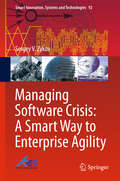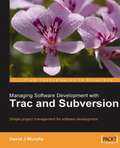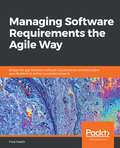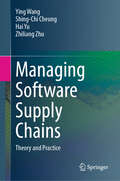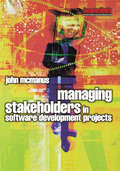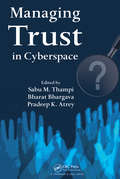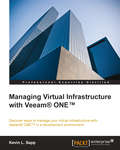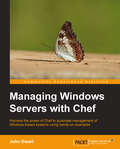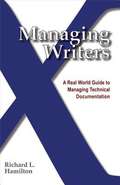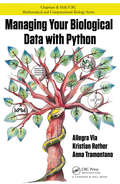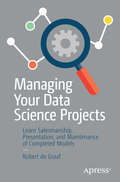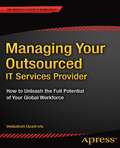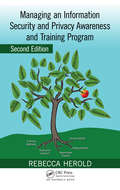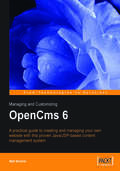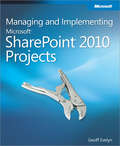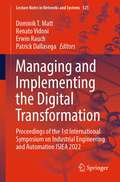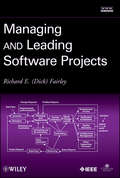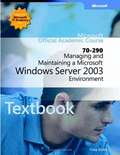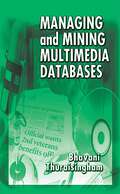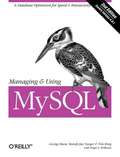- Table View
- List View
Managing Social Media and Consumerism
by RajagopalCategorically reviews the theories of communication, best practices in social media and previous research, and analyzes the corporate involvement towards strategic and tactical stewardship in serving customer-centric business requirements.
Managing Software Crisis: A Smart Way to Enterprise Agility (Smart Innovation, Systems And Technologies #92)
by Sergey V. ZykovThis book discusses smart, agile software development methods and their applications for enterprise crisis management, presenting a systematic approach that promotes agility and crisis management in software engineering. The key finding is that these crises are caused by both technology-based and human-related factors. Being mission-critical, human-related issues are often neglected. To manage the crises, the book suggests an efficient agile methodology including a set of models, methods, patterns, practices and tools. Together, these make a survival toolkit for large-scale software development in crises. Further, the book analyses lifecycles and methodologies focusing on their impact on the project timeline and budget, and incorporates a set of industry-based patterns, practices and case studies, combining academic concepts and practices of software engineering.
Managing Software Development with Trac and Subversion
by David J MurphyThis book combines theory with practical knowledge of how Trac and Subversion can help us to achieve the process of managing the software development. This book is aimed at developers of all calibres, but particularly those that lead teams or projects, especially if they have recently moved into the role or are simply looking for a better way.
Managing Software Requirements the Agile Way: Bridge the gap between software requirements and executable specifications to deliver successful projects
by Fred HeathLearn how to deliver software that meets your clients' needs with the help of a structured, end-to-end methodology for managing software requirements and building suitable systems Key Features Learn how to communicate with a project's stakeholders to elicit software requirements Deal every phase of the requirement life cycle with pragmatic methods and techniques Manage the software development process and deliver verified requirements using Scrum and Kanban Book Description Difficulty in accurately capturing and managing requirements is the most common cause of software project failure. Learning how to analyze and model requirements and produce specifications that are connected to working code is the single most fundamental step that you can take toward project success. This book focuses on a delineated and structured methodology that will help you analyze requirements and write comprehensive, verifiable specifications. You'll start by learning about the different entities in the requirements domain and how to discover them based on customer input. You'll then explore tried-and-tested methods such as impact mapping and behavior-driven development (BDD), along with new techniques such as D3 and feature-first development. This book takes you through the process of modeling customer requirements as impact maps and writing them as executable specifications. You'll also understand how to organize and prioritize project tasks using Agile frameworks, such as Kanban and Scrum, and verify specifications against the delivered code. Finally, you'll see how to start implementing the requirements management methodology in a real-life scenario. By the end of this book, you'll be able to model and manage requirements to create executable specifications that will help you deliver successful software projects. What you will learn Kick-start the requirements-gathering and analysis process in your first meeting with the client Accurately define system behavior as features Model and describe requirement entities using Impact Mapping and BDD Create a feature-based product backlog and use it to drive software development Write verification code to turn features into executable specifications Deliver the right software and respond to change using either Scrum or Kanban Choose appropriate software tools to provide transparency and traceability to your clients Who this book is for This book is for software engineers, business analysts, product managers, project managers, and software project stakeholders looking to learn a variety of techniques and methodologies for collating accurate software requirements. A fundamental understanding of the software development life cycle (SDLC) is needed to get started with this book. Although not necessary, basic knowledge of the Agile philosophy and practices, such as Scrum, along with some programming experience will help you to get the most out of this book.
Managing Software Supply Chains: Theory and Practice
by Ying Wang Zhiliang Zhu Shing-Chi Cheung Hai YuOpen-source software supply chains wield significant influence in the software industry, drawing substantial interest from enterprises, researchers, and policymakers. Leveraging third-party libraries to build software applications is a common practice aimed at cost savings and software quality enhancement. However, heavy reliance on external libraries often leads to a state of “dependency hell”, marked by issues like incompatibilities, conflicting versions, bloated dependencies, and the inclusion of vulnerable library versions. Despite extensive research on software dependency management and the evolution of software supply chains, questions linger regarding the variances in dependency challenges across programming language ecosystems and how best to address the dependency hell phenomenon from an ecosystem-wide perspective. The aim of this book is to offer: (1) a comprehensive literature review on software supply chains, (2) discussions on modeling software supply chains and analyzing their evolutionary behaviors, (3) ecosystem-level strategies for diagnosing various dependency issues and automating problem resolution with cost-benefit analysis, and (4) provision of a toolkit and datasets to support future research and assist practitioners in addressing the challenges of dependency management. The methodologies outlined in this book have been previously presented in top-tier conferences and journals, with some techniques officially integrated into products by Microsoft Corporation and Huawei Technologies Co Ltd. This book is designed to provide readers with a solid understanding of software supply chain fundamentals and practical guidance on implementing theory and techniques in real-world industrial settings. The book is chiefly intended for software engineering researchers and students with an academic background who are interested in learning about dependency management for third-party libraries, quality assurance for software supply chains, and the evolution of open-source software ecosystems. It will also be of interest to practitioners, including software engineers, quality assurance professionals, and software managers, as well as general readers. All will benefit from our systematic studies on the dependency hell phenomenon in various programming language communities and valuable associated artifacts.
Managing Spontaneous Community Volunteers in Disasters: A Field Manual
by Lisa OrloffWhile history has identified a need for improved coordination during emergencies, it has also demonstrated that community volunteers positively impact their neighborhoods during times of crisis. Laying out the rationale and process by which emergency managers, community leaders, and non-governmental aid organizations can effectively collaborate and
Managing Stakeholders in Software Development Projects (Computer Weekly Professional Ser.)
by John McManusAs stakeholder relationships and business in general have become increasingly central to the unfolding of stakeholder thinking, important new topics have begun to take centre stage in both the worlds of practitioners and academics. The role of project management becomes immeasurably more challenging, when stakeholders are no longer seen as simple objects of managerial action but rather as subjects with their own objectives and purposes. This book will aim to explain some of the complexities of project management and managerial relationships with stakeholders by discussing the practice of stakeholder engagement, dialog, measurement and management and the consequences of this practice for reporting and productivity, and performance within project management.
Managing State in Flutter Pragmatically: Discover how to adopt the best state management approach for scaling your Flutter app
by Waleed ArshadExplore popular state management techniques in Flutter and implement them in real-world applicationsKey FeaturesGet to grips with popular approaches for managing your Flutter application stateThink declaratively in order to decide on the most fitting approach for different applicationsLearn to implement state management solutions by building a popular use case in the form of a shopping cart appBook DescriptionFlutter is a cross-platform user interface (UI) toolkit that enables developers to create beautiful native applications for mobile, desktop, and the web with a single codebase. State management in Flutter is one of the most crucial and complex topics within Flutter, with a wide array of approaches available that can make it easy to get lost due to information overload.Managing State in Flutter Pragmatically is a definitive guide to starting out with Flutter and learning about state management, helping developers with some experience of state management to choose the most appropriate solutions and techniques to use. The book takes a hands-on approach and begins by covering the basics of Flutter state management before exploring how to build and manipulate a shopping cart app using popular approaches such as BLoC/Cubit, Provider, MobX, and Riverpod. Throughout the book, you'll also learn how to adopt approaches from React such as Redux and all its types.By the end of this Flutter book, you'll have gained a holistic view of all the state management approaches in Flutter, and learned which approach is the best solution for managing state in your app development journey.What you will learnUnderstand the core concepts of different state management techniques used in FlutterBuild optimal and performant applications in FlutterDevelop an understanding of which technique to apply in what sort of appsBuild the habit of writing clean state management codeProduce code with techniques from beginner to advanced level for different state management solutionsUse state management techniques to create robust and scalable apps in FlutterWho this book is forThis book is for developers who have already started with their Flutter journey and are now looking to learn optimal state management approaches for app development. The book will also help less experienced Flutter engineers to find the best state management solution to fit their app, along with Flutter engineers who want to learn which state management approach should be taken under what circumstances.
Managing Technology in Higher Education
by A. W. Bates Albert SangraUniversities continue to struggle in their efforts to fully integrate information and communications technology within their activities. Based on examination of current practices in technology integration at 25 universities worldwide, this book argues for a radical approach to the management of technology in higher education. It offers recommendations for improving governance, strategic planning, integration of administrative and teaching services, management of digital resources, and training of technology managers and administrators. The book is written for anyone wanting to ensure technology is integrated as effectively and efficiently as possible.
Managing Trust in Cyberspace
by Pradeep K. Atrey Sabu M. Thampi Bharat BhargavaIn distributed, open systems like cyberspace, where the behavior of autonomous agents is uncertain and can affect other agents' welfare, trust management is used to allow agents to determine what to expect about the behavior of other agents. The role of trust management is to maximize trust between the parties and thereby provide a basis for cooper
Managing Virtual Infrastructure with Veeam® ONE™
by Kevin L. SappThis book is aimed at virtualization professionals who want to improve their skills in infrastructure monitoring and management. You need a good understanding of server virtualization and management of virtual environments.
Managing Web Projects (ESI International Project Management Series)
by Edward B. FarkasGetting Web projects done right and delivered on time is all about efficiency. Putting the information you need and tools you can rely on at your ready disposal-Managing Web Projects-is a complete guide for project managers in the Internetworking industry. Whether you are a Web developer or an Internet Service Provider, whether your project is a qu
Managing Windows Servers with Chef
by John EwartThis is a guide to automating Windows infrastructures using Chef, from the big picture through to hands-on examples. This book is designed for systems administrators who have had some exposure to Chef and are interested using it to manage their Windows-based systems. Some exposure to programming or scripting languages is expected for portions of this book.
Managing Writers
by Richard HamiltonManaging Writers is a practical guide to managing documentation projects in the real world. It is informal, but concise, using examples from the author's experience working with and managing technical writers. It looks beyond big project, big team methodologies to the issues faced by smaller, less well-funded projects. Managing Writers is for technical writers, both freelancers and employees, documentation managers, and managers in other disciplines who are responsible for documentation; anyone who may need to manage, full or part-time, a documentation project. Inside the Book Leading People Leading Projects Leading Technology Glossary, Bibliography, and Index
Managing Your Biological Data with Python (Chapman & Hall/CRC Computational Biology Series)
by Anna Tramontano Allegra Via Kristian RotherTake Control of Your Data and Use Python with ConfidenceRequiring no prior programming experience, Managing Your Biological Data with Python empowers biologists and other life scientists to work with biological data on their own using the Python language. The book teaches them not only how to program but also how to manage their data. It shows how
Managing Your Data Science Projects: Learn Salesmanship, Presentation, and Maintenance of Completed Models
by Robert de GraafAt first glance, the skills required to work in the data science field appear to be self-explanatory. Do not be fooled. Impactful data science demands an interdisciplinary knowledge of business philosophy, project management, salesmanship, presentation, and more. In Managing Your Data Science Projects, author Robert de Graaf explores important concepts that are frequently overlooked in much of the instructional literature that is available to data scientists new to the field. If your completed models are to be used and maintained most effectively, you must be able to present and sell them within your organization in a compelling way.The value of data science within an organization cannot be overstated. Thus, it is vital that strategies and communication between teams are dexterously managed. Three main ways that data science strategy is used in a company is to research its customers, assess risk analytics, and log operational measurements. These all require different managerial instincts, backgrounds, and experiences, and de Graaf cogently breaks down the unique reasons behind each. They must align seamlessly to eventually be adopted as dynamic models.Data science is a relatively new discipline, and as such, internal processes for it are not as well-developed within an operational business as others. With Managing Your Data Science Projects, you will learn how to create products that solve important problems for your customers and ensure that the initial success is sustained throughout the product’s intended life. Your users will trust you and your models, and most importantly, you will be a more well-rounded and effectual data scientist throughout your career.Who This Book Is ForEarly-career data scientists, managers of data scientists, and those interested in entering the field of data science
Managing Your Outsourced IT Services Provider
by Venkatesh UpadristaManaging Your Outsourced IT Services Provider teaches executives and managers of organizations how to unleash the full potential of their outsourced IT services workforce and IT-enabled business processes safely and profitably. Drawing on two decades of experience managing client relationships for global IT services companies, Venkatesh Upadrista guides outsourcing organizations around the hazards of geographic distance, linguistic miscommunication, organizational mismatch, and functional disparity between receiver requirements and provider capabilities. The first half of the book describes what an outsourcing organization needs to know about the IT services providers industry in general to deal intelligently with specific providers: namely, the industry's organizational types, strategic drivers, competitive labor market constraints, and tactics for hitting P&L targets. The second half of the book teaches outsourcers how to evaluate prospective providers, craft service level agreements, formalize best practices, and manage the full gamut of receiverAprovider relationships to optimize outcome in terms of cost, timeliness, and quality of services received. The descriptions and prescriptions in Managing Your Outsourced IT Services Provider apply equally to onshore and offshore outsourcing, but examples and case studies focus on offshoring. In addition, Upadrista analyzes the advantages, disadvantages, and special considerations and caveats of single provider outsourcing and captive centers. "
Managing an Information Security and Privacy Awareness and Training Program
by Rebecca HeroldStarting with the inception of an education program and progressing through its development, implementation, delivery, and evaluation, Managing an Information Security and Privacy Awareness and Training Program, Second Edition provides authoritative coverage of nearly everything needed to create an effective training program that is compliant with
Managing and Customizing OpenCms 6 Websites
by Matt ButcherWritten in an accessible and easy to read style, this book is packed with practical advice to help you create your OpenCMS website. This book is for anyone who wants to get an OpenCMS website up and running as quickly as possible, whether you are a user, administrator, designer or webmaster. You do not have to be a Java developer to benefit from this book, although a working knowledge of Java, JSP, and XML will help you to get the most from OpenCMS, and this book.
Managing and Implementing Microsoft® SharePoint® 2010 Projects
by Geoff EvelynDelve into the capabilities of SharePoint® 2010 -- and determine the best way to put this technology to work for your organization. With this practical guide, you'll gain project management practices for implementing SharePoint, and learn how to customize the system to match the unique collaboration and data-sharing needs of your users. Discover how to: Define a SharePoint 2010 system specification based on user requirements Plan your SharePoint implementation and build your team Determine the function, performance, interfaces, and design of your system Optimize your hardware, software, and information architecture Take control of the documentation process during your SharePoint project Manage the implementation to respond to the evolving needs of your organization Your companion content includes a fully searchable online edition of the book -- with unlimited access on the Web. Customize SharePoint 2010 to fit the needs of your business with this hands-on guide.
Managing and Implementing the Digital Transformation: Proceedings of the 1st International Symposium on Industrial Engineering and Automation ISIEA 2022 (Lecture Notes in Networks and Systems #525)
by Dominik T. Matt Erwin Rauch Renato Vidoni Patrick DallasegaThis book shows how companies can practically implement the advantages of Industry 4.0 and digitalization and also addresses the current challenges with regard to engineering education for Industry 4.0. In this book, we collect the contributions of the 1st Symposium on Industrial Engineering and Automation (ISIEA 2022), which took place from June 21–22, 2022 at the Free University of Bolzano. The contributions cover three basic areas: (1) best practice examples and technical solutions for the implementation of Industry 4.0 in production and logistics, (2) management-oriented approaches for the digital transformation in companies, and (3) addressing Industry 4.0 in engineering education. The book targets different readers. Researchers find approaches to current research topics regarding Industry 4.0. Practitioners find valuable examples for technological implementations as well as management approaches for introducing digitalization. Students and lecturers find hints on how Industry 4.0 can be integrated into university teaching.
Managing and Leading Software Projects, 1st Edition
by Richard E. FairleyThe book is organized around basic principles of software project management: planning and estimating, measuring and controlling, leading and communicating, and managing risk. Introduces software development methods, from traditional (hacking, requirements to code, and waterfall) to iterative (incremental build, evolutionary, agile, and spiral). Illustrates and emphasizes tailoring the development process to each project, with a foundation in the fundamentals that are true for all development methods. Topics such as the WBS, estimation, schedule networks, organizing the project team, and performance reporting are integrated, rather than being relegating to appendices. Each chapter in the book includes an appendix that covers the relevant topics from CMMI-DEV-v1.2, IEEE/ISO Standards 12207, IEEE Standard 1058, and the PMI Body of Knowledge.
Managing and Maintaining a Microsoft Windows Server 2003 Environment
by Craig Zacker Microsoft Official Academic Course StaffThis Microsoft Official Academic Course provides everything students need to build the knowledge and skills necessary to install, configure, administer, and support the primary services in the Microsoft Windows Server 2003 operating system and to prepare for the Microsoft Certified Professional examination 70-290: Managing and Maintaining a Microsoft Windows Server 2003 Environment.
Managing and Mining Multimedia Databases
by Bhavani ThuraisinghamThere is now so much data on the Web that managing it with conventional tools is becoming almost impossible. To manage this data, provide interoperability and warehousing between multiple data sources and systems, and extract information from the databases and warehouses, various tools are being developed. In fact, developments in multimedia databa
Managing and Using MySQL, 2nd Edition
by George Reese Tim King Randy Jay YargerLearn how to use MySQL, a popular database product that supports key subsets of SQL on Linux and Unix systems. Using C/C++, Java, Perl, PHP, or Python, you can write programs to interact with a MySQL database, either as a stand-alone application or through a web page. This book covers the whole process, from installation to programming interfaces and database administration. It includes ample tutorial material and examples.

